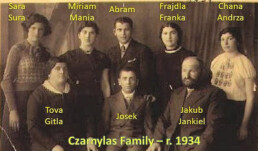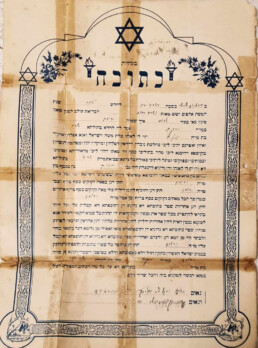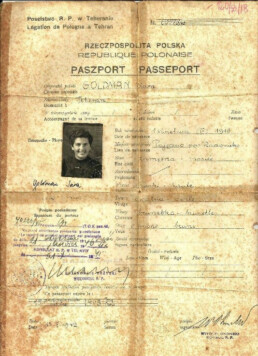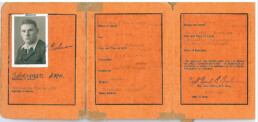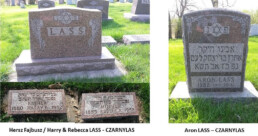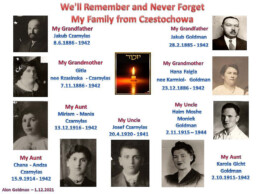The Czarnylas Family
- a tribute to the maternal side of his family by Alon Goldman
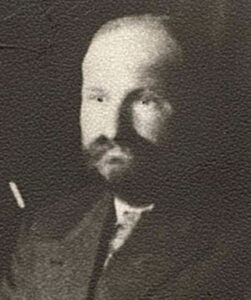
The Czarnylas Family Before World War II
My mother was born on 1st April 1918 in Pajęczno, the sixth daughter of Jakub-Jankiel Czarnylas and Tova Gitla Czarnylas (née Rząśyńska).
Jakub-Jankiel Czarnylas, my grandfather, was also born in Pajęczno on 15th June 1886, to Icek Czarnylas and Frajdla Czarnylas (née Lipszyc), the fifth of their children.
From documents, which I found in the National Archives in Częstochowa, I learned that my grandfather Jakub-Jankiel had six brothers and sisters, who were all born in Pajęczno.:
Jakub-Jankiel, my grandfather, was born on 15th June 1886. His siblings were:
- Szandel, born 17th May 1873
- Abram, born 12th May 1875
- Esther, born 24th March 1878
- Hersz-Herszlik Fajbusz, born on 22nd January 1880
- Aron, born on 19th September 1882
- Nacha, born 1st May 1891
On 6th November 1908, my grandfather Jakub married Tova Gitla Rząśyńska, born 7th November 1886, in Pajęczno, the daughter of Gabriel and Mindla (née Buchman) Rząśyński.
I know nothing about the childhood of my grandparents and their family in Pajęczno, nor where they lived and what their parents did .
My great-grandfather Icek Czarnylas (my grandfather Jakub’s father) died at the advanced age of eighty-two in Pajęczno, on 16th February 1935 (Record No. 1/1935). he was buried in the local cemetery, of which no trace remained after World War II. From his death certificate, I learned that he was born in 1853 to Jakub-Jankiel Czarnylas and Sarah-Sura Czarnylas (née Bursztyn), both permanent residents of Pajęczno. I know nothing about my great-grandmother Frajdla-Freida (Icek’s wife) nor about when and where she died.
My grandparents, Jakub and Tova Gitla had seven children, all born in Pajęczno :
- Frajdla (Franka), born 16th February 1910
- Abram, born 14th November 1911
- Chana (Andrza), born 15th September 1914
- Bejnusz, born 1914, died 13th November 1915
- Miriam (Mania), born 13th December 1916
- Sarah-Sura, my mother, born 1st April 1918
- Joseph-Josek, born 20th April 1920
- Mosze, born July 1922, dec. 20th Sept. 1922
Due to the economic situation between 1920 and 1925, I do not know exactly when my grandfather Jakub and his family moved from Pajęczno to Częstochowa .
My grandfather Jakub was a successful businessman. He owned a sawmill, traded in lumber and, as well as other businesses. was a partner in a mirror manufacturing factory.
In Częstochowa, the Czarnylas family lived in a building owned by the family at ul. Katedralna 4, (on the corner of ul. Ogrodowa). In May 1939, together with two partners, Jakub Czarnylas purchased the building at ul Katedralna 8 in Częstochowa.
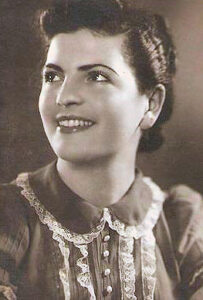
I know very little about my mother’s childhood in Czestochowa. Financially, the family was wealthy and lacked for nothing. A nanny lived with them, who took care of all their needs. Sara attended a high school for girl, and was a member of the Hashomer Hatzair Zionist youth movement. Her sisters, Mania and Franka, joined the Betar Zionist youth movement.
When she was 16 or 17 years old, she first met my father, Jerucham Goldman, who lived on the parallel street (at ul. Fabryczna 22 which, today, is ul. Mielczarskiego 22).
In 1933, her brother Abram immigrated to Israel in order to study at the Hebrew University of Jerusalem.
From research I carried out at the Pajęczno civil registry office, in the National Archives in Częstochowa and other places, I was able to find some information, in the period prior to World War II, about family members of my grandfather Jakub Czarnylas.
On 20th February 1893, in Pajeczno, his sister, Szandel Czarnylas, married Szaja Heller, who was born in Będzin on 23rd November 1869 and died on 10th September 1932.
In 1900, his sister, Esther Czarnylas, married Szlama Joskowicz, who was born in Będzin on 22nd November 1874. The couple had three children: Sarah born 23rd October 1902, Israel Lejbusz born 22nd April 1906 and Ruchla Frajdla born on 3rd October 1911. Esther and Szlama’s son, Israel Lejbusz married Ruchla Matla and, in 1934, they had a son David.
On 28th October 1903, in Pajeczno, my grandfather Jakub’s brother, Hersz-Herszlik Fajbusz Czarnylas, married Hanah Broda). Her family was also from Pajęczno and the couple had four children, all born in Pajęczno:
- Sara, born 28th October 1903
- Bejnusz, 10th April 1907 – 11th June 1910
- Miriam-Maria, born 30th June 1908
- Freida-Frajdela, born 28th September 1909
Hersz Fajbusz’ wife, Hanah, died on 21st January 1911 at the age of only twenty-eight. Two years later, on 22nd April 1913, Hersz Fajbusz married again, this time to Rebecca Minc of Zabkowice. This was also Rebecca’s second marriage. She had a son from her first marriage, Binem, who was born on 7th October 1907.
In Pajęczno, grandfather Jakub’s brother, Aron Czarnylas, married Chaja Ita née Abramowicz and, in Pajęczno, the couple had three children;
- Malka, born on 1st July 1900
- Frajdla, born on 8th May 1910
- Abram,born on 22nd May 1912
Grandfather Jakub’s sister, Nacha Czarnylas, married Jakub-Jankiel Lieberman, a merchant and one of the leaders of the Pajęczno Jewish community. In Pajeczno, the couple had eight children:
- Josef
- Isac
- Szmuel (Szmil)
- Frajdla born 24th June 1916
- Abram, born 10th March 1919
- Mosze Chaim, born 5th October 1921
- Aron, born 9th October 1922
- Meir, born 25th March 1925
The Holocaust
Luck did not play out for the Czarnylas family. On 3rd September 1939, Częstochowa was occupied by the Germans, who also occupied Pajęczno on 4th September 1939. From moment, the lives of the population, in general, and the Jewish population in particular, turned into Hell.
Shortly after the conquest of Częstochowa, in November 1939, my father said to my mother, “This will not end well and we must flee”.
Both, young and in their early twenties, were still unmarried. They came to their parents and offered to join them in escaping to the Russian side of the border, to Lwów, a city which my father had known from his electrical engineering internship, which he had completed just before the outbreak of the war. Their parents refused, claiming that the war would end soon and that there was no point in leaving Poland. In spite of everything, my parents decided to flee and, through difficult means, managed to escape to the Russian side of the border and to reach the city of Lwów. Grandfather Jakub Czarnylas tried to persuade them to return to Częstochowa and asked a rabbi to go on a mission to Russia to find them in Lwów and persuade them to return home to Częstochowa. The rabbi went to Lwów, met them and conveyed the message from their parents. He also gave them a sum of money which the parents had sent for them.
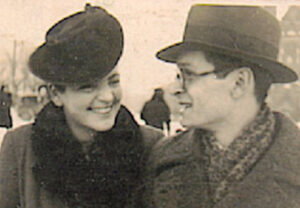
My parents, who were convinced that there was danger in Częstochowa, asked the rabbi to marry them in a Jewish ceremony. So, on 22nd December 1939, my parents were married in a Jewish wedding in Lwów. The rabbi returned to Częstochowa and informed their parents of their marriage.
In 1940, my father found work in a quarry and my mother also found temporary work which enabled them to survive. All the while, they were looking for ways to bring their parents to the Russian side of the border – but without success.
When the Germans invaded Russia in June 1941, my parents fled eastward towards Kazakhstan and Uzbekistan and, after some wandering, came to Tashkent and, from there ,to Samarkand.
In Samarkand, my father found a job in a beer factory. During his work, he fell ill. But, at that time, he could not afford to get sick and so he continued to work. It later turned out that, at that time, he had contracted tuberculosis. How he managed to overcome the disease no one knows .
Life in Russia was not easy to say the least. It was a Hell on Earth. In 1942, when word spread about the possibility that Anders’ Army (Polish Armed Forces in the East) would move westward outside Russia’s borders, my father took advantage of his profession as an electrical engineer and managed to enlist in Anders’ Army in the hope that he could leave Russia with the army .
After a long journey through Iran, Iraq and Lebanon, in May 1943, my father arrived in Mandatory Palestine (now Israel) with Anders’ Army.
My mother managed to leave Russia as the wife of a soldier in Anders’ Army and came to Mandatory Palestine with the Tehran children.
On her way to Palestine, in October 1942, the Polish consulate in Tehran issued her with a passport with which she was allowed to enter Mandatory Palestine .
Pic left: Passport, issued by the Polish consulate in Tehran on 15th October1942, in the name of Sara Goldman née Czarnylas.
In July 1943, Anders’ Army left Palestine for Egypt and, later, for North Africa, joining the Allied forces in Italy. At the end of the war, my parents met again in Palestine.
Arriving in Palestine, my mother met up with her brother Abram Czarnylas. At that time, he was the only family member known to have survived.
I do not know much about what happened to my family members who remained in Poland – in Pajęczno and in Częstochowa. I found the name of my grandfather Jakub Czarnylas on a list of forced labourers in the HASAG Pelcery forced labour camp in Częstochowa and, apparently, the rest of the family were also forced labourers in this factory, which manufactured ammunition for the German war effort.
Almost the entirety of my mother’s family who remained in Częstochowa – her father Jakub, her mother Gitla and her sisters Miriam (Mania) and Hanah (Andrza) – found their deaths, during the liquidation of the “Big Ghetto” in September-October 1942, either in Częstochowa or in Treblinka.
According to testimonies from survivors, Jozef Czarnylas, my mother’s younger brother, was shot in the head by a German soldier in June 1941, when he lit a cigarette without permission while working at the Möbellager. This was a warehouse, on ul. Wilsona in Częstochowa, where the Germans stored furniture removed from Jewish homes in the ghetto.
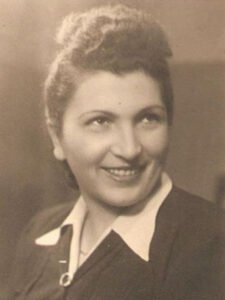 Of the whole family, only one sister, Frajdla (Franka), survived the torment of the Holocaust. According to some documents, it seems that, for a certain period, she was in the Łódź ghetto, from where she returned to Częstochowa. From April 1940 until 16th January 1945, she toiled in HASAG Pelcery of Częstochowa. She was then sent to the Ravensbrück concentration camp, from where she was moved to the Burgau concentration camp, a sub-camp of Dachau. From there, she ended up in the Turkheim concentration camp, from where she was liberated on 27th April 1945.
Of the whole family, only one sister, Frajdla (Franka), survived the torment of the Holocaust. According to some documents, it seems that, for a certain period, she was in the Łódź ghetto, from where she returned to Częstochowa. From April 1940 until 16th January 1945, she toiled in HASAG Pelcery of Częstochowa. She was then sent to the Ravensbrück concentration camp, from where she was moved to the Burgau concentration camp, a sub-camp of Dachau. From there, she ended up in the Turkheim concentration camp, from where she was liberated on 27th April 1945.
Frajdla (Franka) was the only one of the whole family to return, after the end of the war, from the concentration camp to Częstochowa, only to see that no one from the Czarnylas family from Pajęczno and Częstochowa remained alive. As many did, Abram and Sarah in Israel and Frajdla (Franka) in Poland also began looking for survivors until they found each other. In 1948, Frajdla (Franka) left Poland and immigrated to Palestine to reunite with her brother and sister.
I was able to find very little information about the fate of the family members, brothers and sisters of my grandfather Jakub Czarnylas , who remained in Pajęczno.
During the German occupation, Jakub Lieberman, husband of Nacha Czarnylas (my grandfather’s sister) who was one of the leaders of the Pajęczno community, was appointed Chairman of the Judenrat. This was a thankless task, which required him to relate to all refugees from nearby villages and to supply the Germans with labour quotas.
From the beginning of the occupation, the Germans occasionally demanded work crews for camps in the Poznan area. More than once, the Judenrat succeeded in bribing German officials in order to cancel any deportation.
In 1941, the Pajęczno ghetto was established in the poorest part of the city.
Penalty taxes were repeatedly imposed upon the residents of the ghetto. The looting of Jewish property in the ghetto reached its peak in the spring of 1942, two weeks before Passover, when German police went from house to house, beating the residents, taking some as hostages and robbing them of their possessions. In the spring and summer of 1942, the Judenrat was required to hand over certain Jews to the Gestapo. In June 1942, the Chairman of the Judenrat, Jakub Lieberman was himself arrested along with eleven other Jews. They were all murdered by German policemen and, in their place, the Germans appointed the butcher Berl Mrówka to head the Judenrat. According to testimony given to Yad Vashem, Jakub Lieberman and other members of the Judenrat were taken to the Łódź ghetto, where they were executed by hanging.
The liquidation of the Pajęczno ghetto began on 19th August 1942. About 1,800 Jews of the ghetto were brought to a church and were held there for several days under extremely difficult conditions. During those days, another 140 Jews, who were found in hiding places in the ghetto, were forced to join them. On 21st August 1942, the Germans murdered all the elders in the churchyard, including Mrówka, the head of the Judenrat.
On 22nd August 1942, most of the Pajęczno Jews were deported to their deaths in the Chełmno extermination camp. The rest were sent to the Łódź ghetto. Of all the members of the Lieberman family, the only one to survive the Holocaust was Aron Lieberman. On 19th December 1939, he was imprisoned in Pajęczno, from where he moved about between concentration camps – to Monowitz, Fogenbord, Posen (Poznań), Buchenwald and Auschwitz.
Following his liberation in 1945, in a chance meeting with one of his townspeople, he realised that none of his family members had survived the Holocaust and so he had no reason to return to Pajęczno.
Pic below: Aron Lieberman’s ex-concentration camp identity card
Life After the Holocaust
Adapting to life in Israel was not easy for my parents, both in terms of housing and work. They had to cope with a new place, a new language and a difficult economic situation in those first years. On 9th July 1948, my older brother was born and was named Jacob, after his two grandfathers, who perished in the Holocaust. After his birth, my parents bought a three-room apartment in Ramat Gan, where they lived all their lives. I was born in this home on 8th August 1953 .
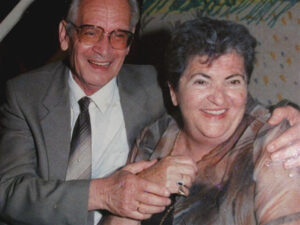 My father Jerucham began his career in Israel with occasional jobs in the electrical field. At one time, he ran a garage specialising in automobile electronics, until he found employment, in large factories, in his profession as an electrical engineer. In 1958, he was appointed Chief Electrical and Maintenance Engineer of the Beilinson Hospital, the biggest hospital in Israel. He worked until he retired in 1986. After retiring, he continued to work for several more years as a consultant to a network of nursing homes and a private hospital in Bnei Brak.
My father Jerucham began his career in Israel with occasional jobs in the electrical field. At one time, he ran a garage specialising in automobile electronics, until he found employment, in large factories, in his profession as an electrical engineer. In 1958, he was appointed Chief Electrical and Maintenance Engineer of the Beilinson Hospital, the biggest hospital in Israel. He worked until he retired in 1986. After retiring, he continued to work for several more years as a consultant to a network of nursing homes and a private hospital in Bnei Brak.
All those years, my mother was a housewife and, when my brother and I were already grown up, she operated a sewing shop in a large textile chain in Israel.
My parents were very happy when they saw the establishment of the next generation of the Czarnylas and Goldman families in Israel. My brother Jacob married Yehudit (née Mendelson) on 13th October 1971. They have two daughters, Liat and Karen, and four grandchildren. I married Dorit (née Sussman) on 16th October 1986. We have three daughters – Tal, Dana and Noa and currently three granddaughters.
My mother, Sarah Goldman (née Czarnylas), passed away on 8th October 1988 and my father Jerucham Goldman passed away on 1st December 2000.
Frajdla (Franka) (née Czarnylas), after immigrating from Poland to Israel, lived in Tel Aviv. She first married in 1950, a marriage that did not last. In 1957 she remarried. Throughout her life, she suffered greatly from health problems caused by everything which she had gone through in the concentration camps. She had no children. She died in Tel Aviv on 10th March 1978.
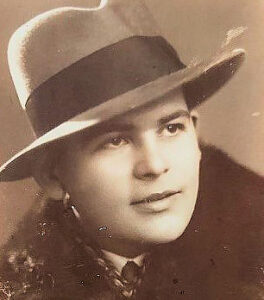 Abram Czarnylas, who came to Israel as a student, married Esther (née Ha’Ivri). They had three children – Prof. Josef Czarnylas (a cardiologist, named after his uncle, who was shot to death in Częstochowa), Nira and Nava. They have eight grandchildren and fourteen great-grandchildren. Abram was a businessman in the field of building materials and real estate. He died of a heart attack in Israel on 24th December 1960, at the age of only forty-nine.
Abram Czarnylas, who came to Israel as a student, married Esther (née Ha’Ivri). They had three children – Prof. Josef Czarnylas (a cardiologist, named after his uncle, who was shot to death in Częstochowa), Nira and Nava. They have eight grandchildren and fourteen great-grandchildren. Abram was a businessman in the field of building materials and real estate. He died of a heart attack in Israel on 24th December 1960, at the age of only forty-nine.
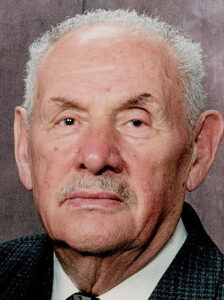 Aron Lieberman (son of Nacha Lieberman – née Czarnylas) was the only survivor of his family. After being released from Auschwitz and, after a chance meeting with his townspeople in a displaced persons camp, he realised that no one from his family was alive and so he went to Eindhoven, in the Netherlands. There, he was adopted by a Dutch family and found a job at Philips Electric. In 1954, he came to Winnipeg, Canada, and, in 1958, he married Dora Wise. Aron had two sons, Jeffrey and Gary, and five grandchildren. After searching for several years, the cousins Aron, Sarah, Abram and Freidla (Franka) found each other. In October 2021, he celebrated his 99th birthday.
Aron Lieberman (son of Nacha Lieberman – née Czarnylas) was the only survivor of his family. After being released from Auschwitz and, after a chance meeting with his townspeople in a displaced persons camp, he realised that no one from his family was alive and so he went to Eindhoven, in the Netherlands. There, he was adopted by a Dutch family and found a job at Philips Electric. In 1954, he came to Winnipeg, Canada, and, in 1958, he married Dora Wise. Aron had two sons, Jeffrey and Gary, and five grandchildren. After searching for several years, the cousins Aron, Sarah, Abram and Freidla (Franka) found each other. In October 2021, he celebrated his 99th birthday.
All these years, we have lived in the knowledge that, with the exception of the four, Abram Carnylas, Freidla-Franka (née Czarnylas), Sarah GOLDMAN ( née Czarnylas) and Aron Lieberman, all the other members of the Czarnylas family perished in the Holocaust.
Complete and Unfinished
In 2014, during one of my visits to Poland, I met Ms. Anna Przybyszewska, from the Genealogy Department of The Emanuel Ringelblum Jewish Historical Institute in Warsaw, in order to try to find more information about my Czarnylas family members from Poland. Unfortunately, at this meeting, no new information was revealed.
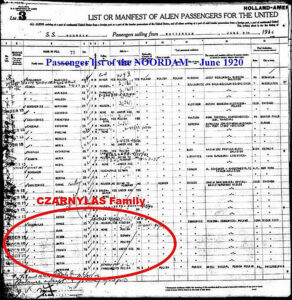 However, a big surprise awaited me in early 2015, seventy years after the end of World War II. I received an email from Anna Przybyszewska in which she wrote that she had come across a passenger list from a ship called the Noordam, which had arrived, on 9th June 1920, at Ellis Island in the United States from Rotterdam in the Netherlands. One of the passengers on this ship’s manifest was Rebecca Czarnylas (aged thirty-five). She was a native of Zabkowice, who had lived in Pajęczno and had arrived with six children – Sarah (aged 17), Binem (13), Maria (11), Frania (10), Zelma (8) and Motka (7). Her husband, Harry Lass, a baker, who lived at 603 Iowa St., Sioux City, Iowa, was waiting for her on the platform, and he was the one who paid for the passage.
However, a big surprise awaited me in early 2015, seventy years after the end of World War II. I received an email from Anna Przybyszewska in which she wrote that she had come across a passenger list from a ship called the Noordam, which had arrived, on 9th June 1920, at Ellis Island in the United States from Rotterdam in the Netherlands. One of the passengers on this ship’s manifest was Rebecca Czarnylas (aged thirty-five). She was a native of Zabkowice, who had lived in Pajęczno and had arrived with six children – Sarah (aged 17), Binem (13), Maria (11), Frania (10), Zelma (8) and Motka (7). Her husband, Harry Lass, a baker, who lived at 603 Iowa St., Sioux City, Iowa, was waiting for her on the platform, and he was the one who paid for the passage.
Another look at Ellis Island’s website, of records of entry to the US, yielded another surprise. On the passenger list of that same ship, the Noordam, arriving in the USA from Rotterdam on 29th October 1920, was Hanah Czarnylas (35) from Pajęczno. She appears with with three children – Malka (aged 18), Frida/Trailo (11) and Abram (9). Her husband, Archie Lass, a baker, who lived at the same address as Harry Lass, 603 Iowa St., Sioux City, Iowa, is also listed as waiting for her on the platform and he also paid for the family’s trip.
Are Harry Lass and Archie Lass, brothers of the Czarnylas family from Pajęczno? Is Harry Lass perhaps Hersz Fajbusz Czarnylas and is Archie Lass perhaps Aron Czarnylas, the brothers of my grandfather Jakub Czarnylas?
In an attempt to solve the mystery, I went back to check the certificates (birth, marriage) of Czarnylas family members from the National Archives in Częstochowa. Given that the passenger list records the age of the passengers when arriving in the United States, together with the place of birth and husband’s occupation, I reasoned that we could compare the details and then determine if the immigrants to the USA were possible family.
From the examination of the documents in my possession, I understood very quickly that the three children (Sarah, Maria and Frania), who came with Rebecca, WERE the children of Hersz Fajbusz Czarnylas, from his marriage to Hana Broda, and that Malka, Frida and Abram were the children of Aron Czarnylas from his marriage to Hana Ita Abramowicz.
I also discovered that Hana Czarnylas (nee Broda) had died in Pajęczno on 21st March 1911 and that Hersz Fajbusz Czarnylas remarried Rebecca Minc of Zabkowice on 13th April 1913. (She was the woman who came to the United States with the children.)
But who were the other three children on the list who came with Rebecca? How do I verify beyond any doubt that Harry and Archie are the brothers of my grandfather Jakub Czarnylas?
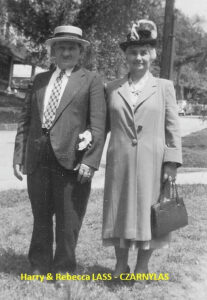 My search on the JewishGen website led me to Katherine Lass from St. Louis, USA, who was looking for information about the Czarnylas from Zabkowice. I contacted her and, after an email exchange and phone calls, the mystery was solved. She told me that Binem (one of the children) was Rebecca’s son from her first marriage and was Katherine’s father. According to what Binem had told Katherine, they were from a small town in Poland and that their family name in Poland was “Black Forest” which, in Polish, is “Czarnylas”. Katherine’s grandmother Rebecca was from the Minc family and Zalma (Sam) and Motke (Max) were children born from Rebecca’s marriage to Harry. In response to my question if she had contact with the rest of the family, she answered that she had no contact, but knew that one cousin, Kenneth Lass, was living in Nashville, Tennessee.
My search on the JewishGen website led me to Katherine Lass from St. Louis, USA, who was looking for information about the Czarnylas from Zabkowice. I contacted her and, after an email exchange and phone calls, the mystery was solved. She told me that Binem (one of the children) was Rebecca’s son from her first marriage and was Katherine’s father. According to what Binem had told Katherine, they were from a small town in Poland and that their family name in Poland was “Black Forest” which, in Polish, is “Czarnylas”. Katherine’s grandmother Rebecca was from the Minc family and Zalma (Sam) and Motke (Max) were children born from Rebecca’s marriage to Harry. In response to my question if she had contact with the rest of the family, she answered that she had no contact, but knew that one cousin, Kenneth Lass, was living in Nashville, Tennessee.
According to Jewish tradition, it is customary to write the Hebrew name and the father’s Hebrew name on a person’s cemetery gravestone. On the one hand, I have the Polish documents with the Hebrew names that were used in Poland but, on the other hand, I have the names that were often written incorrectly when arriving in the US, along with the new names which they adopted. In order to further my investigation, I had the idea to try to locate the burial places of Harry and Archie and to see what is written on their gravestones, and whether the name of their father Isac appears on their gravestones.
My efforts bore fruit and in the Independent Farane Jewish cemetery in Sioux City, Iowa, I found their graves. With the help of Ms. Rhonda Menin, the cemetery director, I obtained pictures of the three graves:
Harry P. Lass – died 7th March 1952 – Section A, Grave 1411
On his tombstone, written in Hebrew, is Zvi Hersz son of Isac/Yitzchak, next to the name Harry, the name which he adopted in the USA. Zvi is Hersz, so Harry’s Hebrew name, year of birth and father’s name matched the documents from Poland.
Harry’s wife Rebecca Lass – died 23rd May 1958 – Section A, Grave 1412
Rebecca’s father’s name, David, which appears on the tombstone, is the same as her father’s name which appears on her marriage certificate to Hersz Fajbusz (Harry) from Poland .
Archie Lass – died 4th November 1941 – Section A, Grave 1414
On his tombstone is written, in Hebrew, Aron son of Isac/Yitzchak Lass.
Exactly when Hersz Fajbusz and Aron, my grandfather’s older brothers, immigrated to the United States, I do not know.
My mother never talked about family in the USA and I guess, until the day she died, she did not know about all of it. So all these years we lived thinking that the whole Czarnylas family had perished in the Holocaust. In my estimation, they left for the USA sometime after 1913 and, after establishing themselves, in 1920, they brought their wives and children.
Thanks to difficult genealogical research, I found some of the Czarnylas descendants all over the United States in such places as Dallas, Houston, El Paso, Plano, Chicago, Springfield, Nashville, Beverly Hills and Los Angeles.
When I contacted them, it was a huge surprise and big shock for them – the discovery of an unknown chapter in their family history which begins in Pajęczno in Poland, about which they knew nothing.
This is where my story ends – the story of the Czarnylas family from Pajęczno and Częstochowa, Poland. I do not know everything and there are many things which I will never know .
Webmaster’s Comment:
The contents on this page,
about the maternal side of his family
has been supplied by
Alon Goldman,
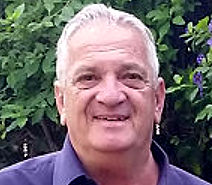
Chairman of the
Association of Częstochowa Jews in Israel,
Vice-President of the World Society of Częstochowa Jews & Their Descendants.
Below, he writes a little about himself:

